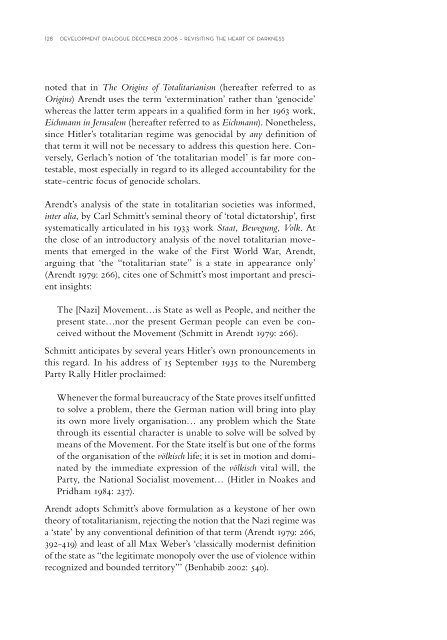60 years after the UN Convention - Dag Hammarskjöld Foundation
60 years after the UN Convention - Dag Hammarskjöld Foundation
60 years after the UN Convention - Dag Hammarskjöld Foundation
Create successful ePaper yourself
Turn your PDF publications into a flip-book with our unique Google optimized e-Paper software.
128 development dialogue december 2008 – revisiting <strong>the</strong> heart of darkness<br />
noted that in The Origins of Totalitarianism (here<strong>after</strong> referred to as<br />
Origins) Arendt uses <strong>the</strong> term ‘extermination’ ra<strong>the</strong>r than ‘genocide’<br />
whereas <strong>the</strong> latter term appears in a qualifi ed form in her 1963 work,<br />
Eichmann in Jerusalem (here<strong>after</strong> referred to as Eichmann). None<strong>the</strong>less,<br />
since Hitler’s totalitarian regime was genocidal by any defi nition of<br />
that term it will not be necessary to address this question here. Conversely,<br />
Gerlach’s notion of ‘<strong>the</strong> totalitarian model’ is far more contestable,<br />
most especially in regard to its alleged accountability for <strong>the</strong><br />
state-centric focus of genocide scholars.<br />
Arendt’s analysis of <strong>the</strong> state in totalitarian societies was informed,<br />
inter alia, by Carl Schmitt’s seminal <strong>the</strong>ory of ‘total dictatorship’, fi rst<br />
systematically articulated in his 1933 work Staat, Bewegung, Volk. At<br />
<strong>the</strong> close of an introductory analysis of <strong>the</strong> novel totalitarian movements<br />
that emerged in <strong>the</strong> wake of <strong>the</strong> First World War, Arendt,<br />
arguing that ‘<strong>the</strong> “totalitarian state” is a state in appearance only’<br />
(Arendt 1979: 266), cites one of Schmitt’s most important and prescient<br />
insights:<br />
The [Nazi] Movement…is State as well as People, and nei<strong>the</strong>r <strong>the</strong><br />
present state…nor <strong>the</strong> present German people can even be conceived<br />
without <strong>the</strong> Movement (Schmitt in Arendt 1979: 266).<br />
Schmitt anticipates by several <strong>years</strong> Hitler’s own pronouncements in<br />
this regard. In his address of 15 September 1935 to <strong>the</strong> Nuremberg<br />
Party Rally Hitler proclaimed:<br />
Whenever <strong>the</strong> formal bureaucracy of <strong>the</strong> State proves itself unfi tted<br />
to solve a problem, <strong>the</strong>re <strong>the</strong> German nation will bring into play<br />
its own more lively organisation… any problem which <strong>the</strong> State<br />
through its essential character is unable to solve will be solved by<br />
means of <strong>the</strong> Movement. For <strong>the</strong> State itself is but one of <strong>the</strong> forms<br />
of <strong>the</strong> organisation of <strong>the</strong> völkisch life; it is set in motion and dominated<br />
by <strong>the</strong> immediate expression of <strong>the</strong> völkisch vital will, <strong>the</strong><br />
Party, <strong>the</strong> National Socialist movement… (Hitler in Noakes and<br />
Pridham 1984: 237).<br />
Arendt adopts Schmitt’s above formulation as a keystone of her own<br />
<strong>the</strong>ory of totalitarianism, rejecting <strong>the</strong> notion that <strong>the</strong> Nazi regime was<br />
a ‘state’ by any conventional defi nition of that term (Arendt 1979: 266,<br />
392-419) and least of all Max Weber’s ‘classically modernist defi nition<br />
of <strong>the</strong> state as “<strong>the</strong> legitimate monopoly over <strong>the</strong> use of violence within<br />
recognized and bounded territory”’ (Benhabib 2002: 540).

















